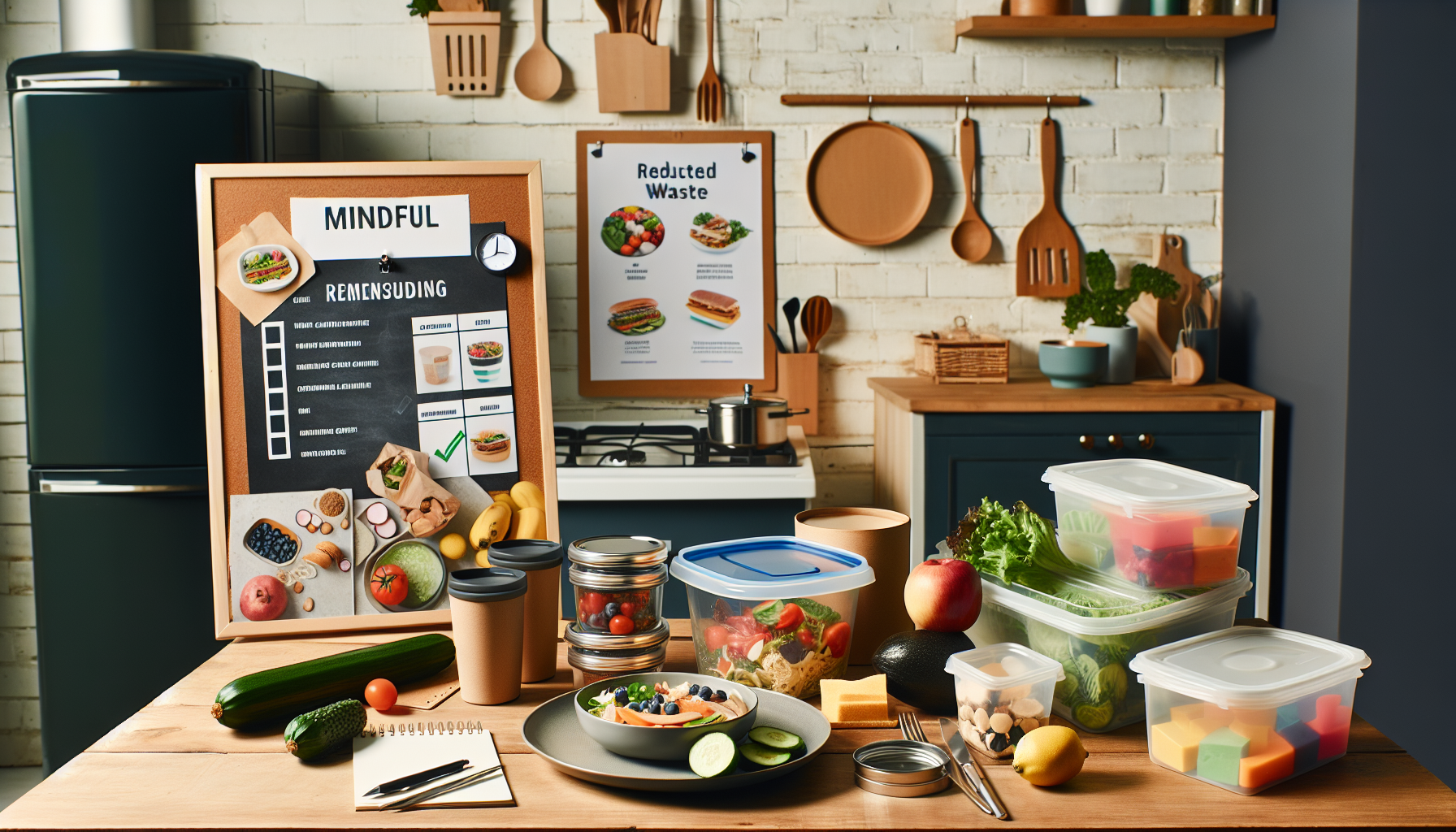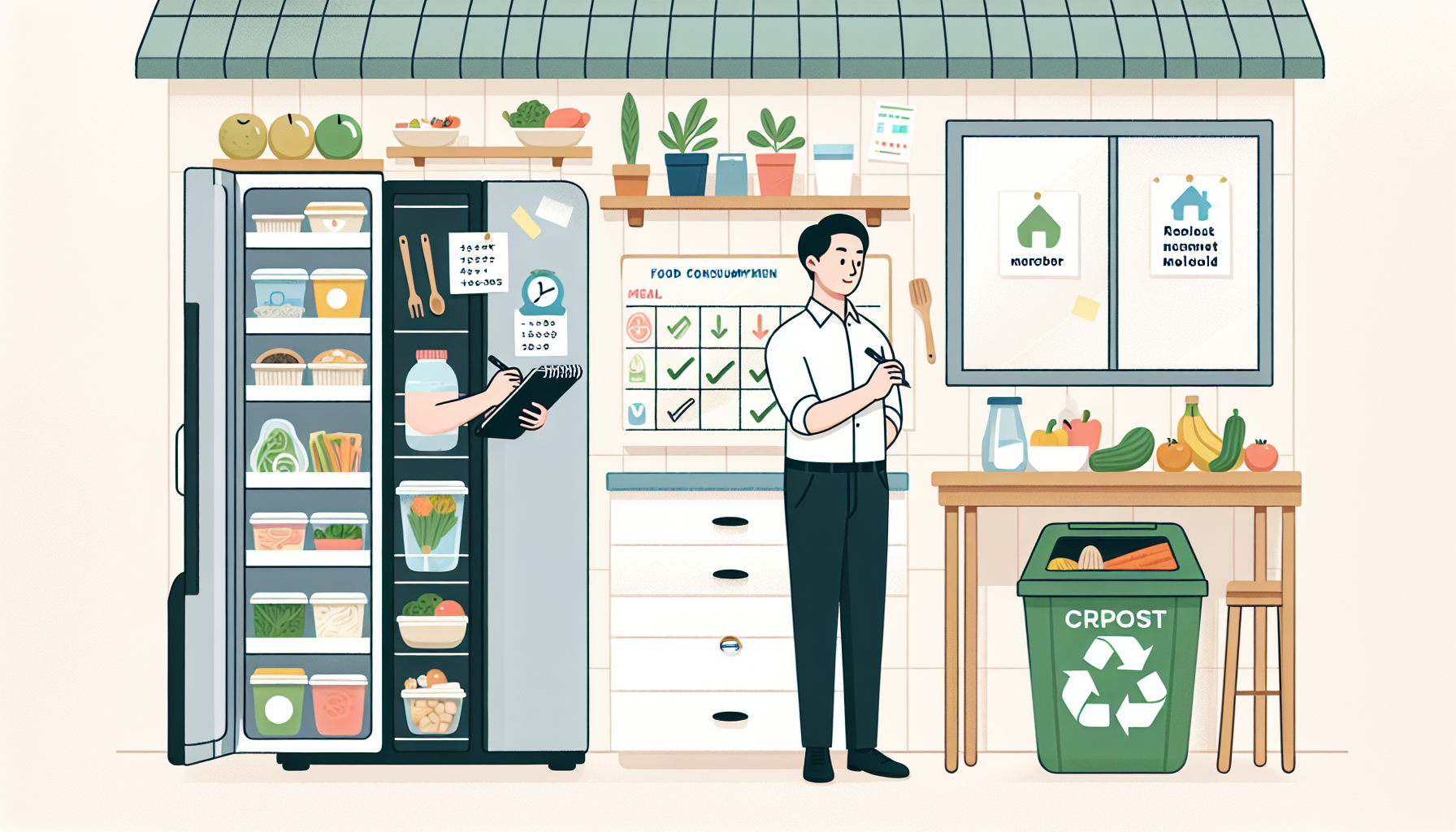Have you ever wondered about the impact of cooking for one on food waste? In today’s busy world, more and more people are finding themselves cooking meals for just themselves. However, this shift towards solo cooking can have unintended consequences when it comes to food waste. With fewer mouths to feed, portion sizes can become a challenge, leading to excess ingredients that often end up in the trash. In this article, we will explore the relationship between cooking for one and food waste, offering practical tips and solutions to help minimize wastage and make the most of your meals.
The Impact of Cooking for One
Food waste and cooking for one
Cooking for one can have a significant impact on food waste. When cooking for a single person, it can be challenging to use all the ingredients before they spoil, leading to a higher likelihood of food waste. The lack of portion control and the difficulty in finding recipes that cater to one serving can also contribute to this issue. However, with the right strategies and techniques, cooking for one can be both enjoyable and efficient, minimizing food waste in the process.
Statistics on cooking for one and food waste
Statistics show that a substantial amount of food is wasted due to cooking for one. According to a study by the Natural Resources Defense Council, single-person households in the United States waste about 33 percent of the food they purchase. This is significantly higher than the food waste rate of larger households. Additionally, the study found that single-person households have a higher proportion of fruits and vegetables going to waste compared to households with multiple members. These statistics highlight the need for effective solutions to reduce food waste when cooking for one.
Challenges of cooking for one
Cooking for one comes with its own set of challenges. One of the main difficulties is overbuying ingredients, as it can be challenging to find products in smaller portions. As a result, many items may go unused and ultimately end up in the trash. Furthermore, expiration dates can pose a problem, as single individuals may struggle to finish perishable items before they spoil. Another challenge is portion control, as standard recipes are often designed for multiple servings, leading to either leftovers or wasted ingredients. Lastly, managing leftovers can be tricky if there is limited space or if the person does not enjoy eating the same meal multiple times in a row.
Benefits of cooking for one
While there are certainly challenges associated with cooking for one, there are also many benefits. One significant advantage is the opportunity for individual meal customization. When cooking for yourself, you have the freedom to choose the ingredients, flavors, and portion sizes that suit your personal preferences. This allows for a higher level of control over your diet, leading to healthier eating habits. Additionally, cooking for one can be more economical, as you can better manage your food budget by buying smaller quantities. Moreover, cooking for yourself provides an excellent opportunity to develop and enhance your cooking skills, leading to a greater sense of creativity and satisfaction in the kitchen.
Factors Contributing to Food Waste
Overbuying and expiration dates
Overbuying and expiration dates are significant factors contributing to food waste when cooking for one. Single individuals often face the challenge of not being able to find smaller portions of ingredients, leading to the purchase of more than they can consume before the items spoil. Additionally, expiration dates can be a cause for concern, as single individuals may struggle to finish perishable items within the designated timeframe. This can result in an unnecessary amount of food being thrown away, contributing to food waste.
Lack of portion control
Another factor that contributes to food waste when cooking for one is the lack of portion control. Many recipes are designed to serve multiple people, which can lead to leftover portions that may go uneaten. It can be challenging to adjust recipes to cater to a single serving, and the temptation to cook the full recipe often results in wasted food. The lack of portion control also extends to meal planning, where individuals may prepare larger quantities than necessary, leading to excess food that eventually goes to waste.
Leftovers management
Leftover management can be a challenging aspect of cooking for one. While some people enjoy eating leftovers, others may struggle to incorporate them into their meals. Limited freezer space or a lack of enthusiasm about consuming the same meal repeatedly can lead to leftovers being discarded. Without proper planning and creativity, leftovers can quickly become a major contributor to food waste when cooking for one.

Strategies to Reduce Food Waste
Meal planning and ingredient optimization
One effective strategy to reduce food waste when cooking for one is meal planning. By carefully considering the meals you will prepare for the week ahead, you can minimize the chances of ingredients going unused and eventually being wasted. Take stock of the ingredients you already have and plan your meals around them, ensuring that nothing goes to waste. Additionally, consider buying only the necessary quantities of ingredients, especially perishable items, to prevent overbuying.
Using leftovers creatively
To minimize food waste, it is essential to utilize leftovers creatively. Leftover ingredients can be repurposed into new dishes, preventing them from being thrown away. For example, leftover chicken can be transformed into a delicious chicken salad or used as a topping for a homemade pizza. By getting creative with your leftovers, you can save money and reduce food waste.
Preserving and freezing food
Preserving and freezing food is another effective strategy to reduce waste when cooking for one. If you have ingredients that are about to spoil, but you are unable to use them immediately, consider preserving or freezing them. This can be done through techniques such as canning, pickling, or using airtight containers for freezing. By extending the shelf life of your ingredients, you can avoid wasting food and save money in the process.
Sharing meals or joining meal-sharing programs
Sharing meals or joining meal-sharing programs can also help reduce food waste. If you often find yourself with excess food, consider sharing it with friends, family, or neighbors. This not only prevents waste but fosters a sense of community and connection. Additionally, there are meal-sharing programs where individuals can donate or exchange meals with others in their local area. These programs provide an excellent opportunity to reduce food waste while supporting those in need.
Techniques to Maximize Ingredients
Batch cooking
Batch cooking is a technique that involves preparing larger quantities of food and storing individual portions for later consumption. This approach allows you to utilize ingredients more efficiently by cooking once and enjoying multiple meals from the same preparation. By spending a little extra time in the kitchen, you can save valuable time and effort throughout the week. Batch cooking is especially beneficial when cooking for one, as it minimizes the risk of wasting ingredients and provides a variety of meals to choose from.
Cooking in smaller quantities
Cooking in smaller quantities is another technique that can be beneficial when cooking for one. Instead of following recipes designed for multiple servings, adapt them to suit a single portion. This prevents the need to cook larger quantities that may lead to leftovers or wasted ingredients. Learning to estimate ingredient quantities accurately and adjust recipes accordingly is a valuable skill that can greatly reduce food waste.
Ingredient substitutions and flexibility
Being flexible with ingredients and making substitutions is a useful technique to maximize ingredients when cooking for one. Instead of strictly adhering to a recipe that calls for specific ingredients, explore alternatives that can be used interchangeably. For example, if a recipe calls for a particular vegetable that you don’t have, consider using a similar vegetable that you already have in your kitchen. This allows you to use what you have on hand and reduces the need to purchase additional ingredients that may go to waste.

Benefits of Cooking for One
Economical advantages
Cooking for one provides significant economical advantages. By purchasing ingredients in smaller quantities and minimizing food waste, you can save money on groceries. Additionally, cooking your meals allows you to avoid the high costs associated with eating out or ordering takeout regularly. By being mindful of your food consumption and utilizing techniques to maximize ingredients, you can enjoy delicious and cost-effective meals when cooking for one.
Health benefits
Cooking for one also offers numerous health benefits. When you prepare meals at home, you have complete control over the ingredients you use, allowing you to make healthier choices. By incorporating fresh fruits, vegetables, lean proteins, and whole grains into your meals, you can improve your nutrition and overall well-being. Cooking for yourself also provides the opportunity to experiment with different flavors and cooking techniques, enhancing the enjoyment of your meals and promoting a healthy relationship with food.
Enhanced cooking skills and creativity
One often overlooked benefit of cooking for one is the opportunity to enhance cooking skills and foster creativity in the kitchen. When you are the sole chef, you have the freedom to experiment with new recipes, techniques, and flavors. This allows you to expand your culinary repertoire and develop a greater understanding of various cooking methods. As you become more comfortable and confident in the kitchen, your creativity will flourish, enabling you to create unique and satisfying meals tailored to your preferences.
Innovative Solutions and Technologies
Smart kitchen appliances
Smart kitchen appliances are revolutionizing the way we cook and reducing food waste. These appliances often come equipped with features such as built-in scales, recipe suggestions, and inventory management systems. By tracking ingredient quantities and offering recipe customization options, smart appliances can help individuals optimize their ingredient usage and minimize waste. For example, a smart refrigerator can alert you when ingredients are about to expire, helping you prioritize their use and reduce unnecessary waste.
Food-sharing apps
Food-sharing apps have emerged as a popular solution to combat food waste. These apps connect individuals and businesses with surplus food to those who are in need or looking to reduce their own waste. Individuals can list and donate excess food items, ensuring that they do not go to waste. These apps provide a convenient and efficient way to connect and support the community while reducing food waste on a larger scale.
Food waste composting
Food waste composting is an innovative solution that helps divert organic waste from landfills. Composting involves decomposing food waste, such as fruit and vegetable scraps, and converting it into nutrient-rich soil. This soil can then be used for gardening or sold to farmers. By composting food waste, individuals can contribute to a more sustainable food system while reducing the environmental impact of landfills.
Community Initiatives and Support
Educational programs on reducing food waste
Educational programs focused on reducing food waste can play a significant role in raising awareness and providing individuals with the knowledge and tools to make a difference. These programs can offer workshops, classes, and resources that teach participants about meal planning, proper portion control, and creative ways to use leftovers. By educating individuals about the impact of food waste and offering practical solutions, these initiatives empower communities to make more informed choices when it comes to cooking for one.
Community gardens and food banks
Community gardens and food banks are valuable resources that support individuals in reducing food waste and addressing food insecurity. Community gardens provide individuals with the opportunity to grow their food, ensuring access to fresh produce and fostering a sense of community. Food banks serve as a hub for donated food items, distributing them to those in need. By supporting or utilizing these community initiatives, individuals can make a positive impact on both food waste reduction and food security in their local area.
Cooking classes and workshops for singles
Cooking classes and workshops specifically tailored for singles can be highly beneficial in addressing the challenges and promoting the benefits of cooking for one. These classes can teach individuals how to adapt recipes for single servings, provide tips for managing leftovers, and offer creative meal ideas. By attending these classes, individuals can gain valuable skills, knowledge, and a supportive community that fosters a love for cooking and minimizes food waste.
Cultural Perspectives and Traditions
Cultural differences in cooking for one
Cultural differences play a significant role in cooking for one. In some cultures, meals are often shared with family or friends, making it less common to cook for oneself. This can result in individuals preparing larger quantities of food, leading to potential waste. On the other hand, cultures with a strong tradition of communal eating may have ingrained practices in place to minimize food waste. Understanding and appreciating cultural perspectives can provide insight into strategies and techniques that can be implemented successfully when cooking for one.
Traditional recipes for one
Traditional recipes for one can provide a valuable resource for those cooking alone. Many cultures have specific dishes that are designed to be enjoyed by individuals. These meals are often simple, nutritious, and easy to prepare in smaller quantities. Exploring traditional recipes for one can not only provide inspiration for new and exciting meals but also offer an opportunity to explore cultural traditions and customs through food.
Intergenerational knowledge sharing
Intergenerational knowledge sharing is a powerful way to preserve cultural traditions and address food waste. Older generations often possess valuable insights, techniques, and recipes that can be shared with younger individuals cooking for one. By fostering communication and collaboration between different age groups, communities can strengthen their culinary traditions, reduce food waste, and promote a sense of belonging and cultural pride.
The Role of Education and Awareness
Teaching individuals about proper meal planning
Proper meal planning is a crucial skill that can significantly reduce food waste when cooking for one. By educating individuals about the importance of meal planning and providing practical tips and resources, they can make informed decisions about the quantity and variety of ingredients they need. Teaching individuals how to plan their meals around perishable items and adapt recipes for single servings can empower them to minimize food waste and save money in the process.
Educating about portion control
Portion control is key to reducing food waste when cooking for one. Many individuals struggle with estimating appropriate portion sizes, leading to leftovers or wasted ingredients. By educating individuals about portion control and teaching them how to adjust recipes accordingly, they can better manage their food consumption and minimize waste. Providing portion measurement tools and guidelines can also aid in promoting mindful eating habits and reducing excess food.
Promoting mindful consumption
Promoting mindful consumption is crucial in the fight against food waste. By raising awareness about the environmental and economic impacts of food waste, individuals can make more conscious choices when cooking for one. Encouraging individuals to evaluate their personal food consumption habits and, if necessary, make adjustments such as reducing portion sizes, utilizing leftovers, and shopping smartly can create a culture of mindful consumption that embraces sustainability and waste reduction.
Government Policies and Environment
Waste management regulations
Government policies play a significant role in addressing food waste at both the consumer and commercial levels. Waste management regulations can include initiatives such as mandatory organic waste separation, composting programs, and landfill diversion targets. By enforcing these regulations, governments can incentivize individuals and businesses to reduce food waste and promote sustainable practices. Additionally, policies that encourage proper education and awareness around food waste can further support waste reduction efforts.
Incentives for reducing food waste
Government incentives can also be instrumental in reducing food waste. By offering financial or tax incentives to individuals or businesses that actively work towards waste reduction, governments can promote behavioral change. These incentives can include tax breaks for businesses that donate excess food to food banks, grants for community initiatives focused on food waste reduction, or subsidies for individuals who invest in composting systems. By rewarding and supporting those who prioritize waste reduction, governments can create a more sustainable and conscious society.
Impact on carbon footprint
Reducing food waste has a significant impact on reducing carbon emissions, making it an essential aspect of environmental sustainability. When food is wasted, not only are the resources required for its production, transportation, and storage wasted, but the resulting decomposition in landfills also generates methane, a potent greenhouse gas. By addressing food waste through effective strategies and education, individuals can contribute to reducing their carbon footprint and promoting a more environmentally friendly future.
In conclusion, cooking for one has a profound impact on food waste. Challenges such as overbuying, lack of portion control, and managing leftovers can contribute to unnecessary waste. However, there are various strategies and techniques to reduce food waste when cooking for one. Meal planning, using leftovers creatively, and preserving food are effective ways to maximize ingredients and minimize waste. Additionally, smart kitchen appliances, food-sharing apps, and composting initiatives offer innovative solutions. Community initiatives, cultural perspectives, and educational programs play a vital role in supporting individuals in reducing food waste. Education, awareness, and government policies further contribute to waste reduction and environmental sustainability. By embracing the benefits of cooking for one and implementing these strategies, individuals can enjoy economical advantages, improve their health, and develop enhanced cooking skills while reducing their carbon footprint and contributing to a more sustainable food system.
